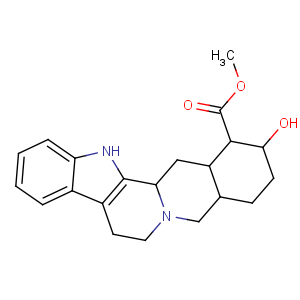
- Willkommen bei VVchem.Anmelden | Freie Registrierung
Sourcing Großaufträge? Visit Lookchem.com

| Produktsname: | methyl (1S,15R,18S,19R,20S)-18-hydroxy-1,3,11,12,14,15,16,17,18,19,20, 21-dodecahydroyohimban-19-carboxylate |
| CAS Registry Number: | 146-48-5 |
| EINECS: | 205-672-0 |
| Synonyme: |
Aphrodyne; Yocon; Corynine;methyl (1S,15R,18S,19R,20S)-18-hydroxy-1,3,11,12,14,15,16,17,18,19,20, 21-dodecahydroyohimban-19-carboxylate; APHRODINE; Yohimex; Quebrachine; Aphrosol; Quebrachin;Yohimbin; |
| Molecular Structure: |
 |
| Molecular Formula: | C21H26N2O3 |
| Molecular Weight: | 354.44274 |
| Dichte: | 1.31 g/cm3 |
| Boiling Point: | 543 °C at 760 mmHg |
| Schmelzpunkt: | 231-233 °C(lit.) |
| Flash Point: | 282.2 °C |
| Brechungsindex: | 1.66 |
| Risiko-Codes: | 23/24/25-39 |
| S-Sätze: | Poison by ingestion, subcutaneous, intravenous, and intraperitoneal routes. Experimental reproductive effects. Human systemic effects: ataxia, heart rate changes, paresthesia.Cases of poisoning have occurred from its use as an aphrodisiac. Upon local application it produces anesthesia. However, absorption of it can give rise to toxic symptoms, such as salivation, increased respiration, and diarrhea. With reference to the circulatory system, there may be a fall in blood pressure and sometimes myocardial damage, involving particularly the conduction system of the heart, with a resultant decrease in the efficiency of the heart. An adrenergic blocker used to treat arteriosclerosis and angina pectoris. Formerly used as a local anesthetic and mydriatic (pupillary dilator). When heated to decomposition it emits toxic fumes of NOx. |
| Gefahrensymbole: | Said to be an aphrodisiac. Toxic by ingestion. |